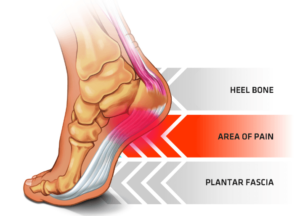Here in the Sunshine State, we’re fortunate to have some of the most picturesque beaches in the world. Thousands of Floridians and visitors alike take advantage of the beautiful scenery by taking long walks on the beach — and with good reason.
While there are certainly some benefits to walking on the beach, including improved cardiovascular health and decreased stress levels, walking barefoot in the soft sand for long distances can take an unexpected toll on your feet. In fact, it can cause a condition called plantar fasciitis.
What is Plantar Fasciitis?
Plantar fasciitis is a condition of the arch and heel of the foot that causes significant pain. It stems from the inflammation of the plantar fascia, which is the tissue that runs across the bottom of your foot and connects your heel bone to your toes.

Walking on the soft, bumpy dunes can exacerbate this inflammation, especially when one walks barefoot without any arch support.
The condition isn’t just limited to walks in the sand, though. Ever notice that your first few steps are painful after standing all day? If so, it’s possible you have plantar fasciitis. You’re more likely to get this condition if you have high arches or flat feet, walk or run for an extended time, or have tight tendons, calf or ankle muscles. If you wear worn-out shoes that don’t bend at the ball of your feet, the lack of arch support can cause plantar fasciitis.
How Can You Avoid Plantar Fasciitis?
 To minimize your risk for plantar fasciitis, try to relax when you walk or run. Holding tension in your legs or calf muscles can make you more susceptible to this condition. If you love to walk on the beach, try to go for shorter walks on the hard-packed sand close to the water. Icing your arch and stretching your calf muscles before you go may also help avoid injury.
To minimize your risk for plantar fasciitis, try to relax when you walk or run. Holding tension in your legs or calf muscles can make you more susceptible to this condition. If you love to walk on the beach, try to go for shorter walks on the hard-packed sand close to the water. Icing your arch and stretching your calf muscles before you go may also help avoid injury.
If you are an avid runner, practice better form to prevent over-striding, which causes you to land on your heel with each step. Rest your feet as much as possible and consider buying new running shoes if you’ve worn out your current pair.
Most cases of plantar fasciitis resolve themselves without surgery, but it can take several months to feel total relief and before you can return to full activity. If over-the-counter medications, icing, stretching or rest do not improve your pain, you may have a heel bone stress fracture or tarsal tunnel syndrome, a painful condition that occurs when the nerve between your foot and ankle compresses. Either way, be sure to visit a doctor if your pain worsens. A medical professional can help control or get rid of it so you can return to the activities you enjoy, like long walks on the beach.
Bio:
Robert Duggan, DPM is board certified in podiatric surgery. He specializes in diagnosing and treating conditions and injuries of the foot, ankle and related structures of the leg in patients of all ages.





Comments